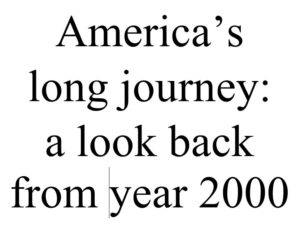
The election of 1860
In 1860, the nation’s last party to span both North and South was The Democracy. (Most of the anti-slavery men of the defunct Whig Party had joined the new Republican Party. But Republicans were not even allowed on the ballot in several Southern states.) By 1860, the Democracy’s most prominent son was Illinois Senator Stephen A. Douglas, Chairman of the Committee on Territories, popularly known as “the little giant.”
The party convention met in Charleston, South Carolina, in late April. From the beginning it was doomed, deliberately, by Southern extremists. They were determined to split the Democracy, which would assure the election of a Republican president (then expected to be William Seward), which they expected to precipitate a wave of Southern state declarations of secession from the Union. Some of them had been working on this for ten years, as we shall see. In the event, they got exactly what they wanted, and thus brought catastrophe upon themselves and their cause and their section and the Union.
Douglas went into the convention the clear leader, with a good half of the delegates. But most of them were Northern men, and Douglas faced implacable opposition from the Deep South. (Douglas, as we shall see, had lost much of previously considerable Southern support in his response to Lincoln’s question at Freeport, Illinois, two years before, during the second debate of their Senatorial contest.)
The Southern-controlled platform committee called for Congress to enact a slave code for the Territories, which would mean Federal protection for slavery everywhere. Delegates from the North pointed out that they would lose every Northern state if they included such a plank in the party platform, and so the convention adopted the platform committee’s minority report, which rejected the idea. Fifty delegates from seven Southern states promptly withdrew from the convention.
When the remaining delegates voted on a presidential nominee, Douglas received about 60 percent of the 250 votes, but in those days (and until Franklin Roosevelt got the rules changed after the 1932 election) nomination required a 2/3 majority. After 10 days and 57 ballots, the convention adjourned. When it reconvened on June 18 in Baltimore, the delegates who had withdrawn were replaced, which caused most of the remaining Southern delegates to withdraw. Douglas was then nominated by 190 1/2 votes of 203 1/2 cast.
The Southerners who had bolted the party nominated not one, but two slates. Southern Democrats named Vice President John Breckinridge. Some former Whigs formed the Constitutional Union Party and nominated John Bell. The resulting four-way race allowed the Republicans to win without capturing a single Southern state, the first time this had ever happened, just as the fire-eaters had predicted and worked for.
Douglas’ role in the campaign earns his forgiveness for a multitude of previous political sins. He campaigned energetically, attacking abolitionism in the North, and disunion in the South. Then, in early October, when the Republicans won state elections in Ohio and Pennsylvania, Douglas told his secretary “Mr. Lincoln is the next President. We must try to save the Union. I will go south.” He went to the South to rally Unionist sentiment. At Raleigh, North Carolina, he said “I am in favor of executing in good faith every clause and provision of the Constitution and protecting every right under it – and then hanging every man who takes up arms against it!”
The final results were
Party Candidate Popular votes Electoral votes
Republican Abraham Lincoln 1,866,452 180
Democratic Stephen A. Douglas 1,382,713 12
Democratic John C. Breckinridge 847,953 72
Constitutional Union John Bell 592,906 39
The disruption of the Democracy had let in Abraham Lincoln and the Republicans, just as some had planned it – and it was the end of an era.